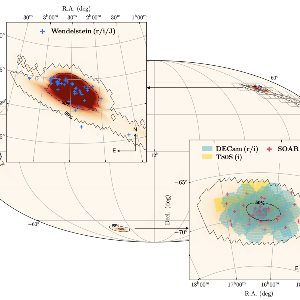Neutron star merger event S250206dm: no needle in this haystack
4 Jul 2025
Two recent publications analyze the potential optical counterpart to a neutron star merger, a so-called kilonova.
4 Jul 2025
Two recent publications analyze the potential optical counterpart to a neutron star merger, a so-called kilonova.

Figure taken from Hu et al.
It has been almost 8 years since the discovery of the first and so far only optical counterpart to a neutron star merger, a so-called kilonova, detected by its gravitational wave signature: GW170817.
Cosmic collisions involving neutron stars seem to be less common than hoped then, but the LIGO-Virgo-Kagra collaboration identified gravitational waves from one likely such event on February 6 of this year, S250206dm. LMU scientists from the Gruen and Bender chairs, including numerous students, contributed to a search with observatories around the globe, notably the Dark Energy Camera and a smaller companion telescope at the Blanco Telescope on Cerro Tololo, Chile, SOAR on the opposing summit, the Zwicky Transient Factory at Palomar Observatory, and the Fraunhofer Telescope at Wendelstein.
As presented in two preprints out this week, these efforts jointly had approximately a 50% chance of discovering an optical counterpart, in case one existed. This is impressive given the difficult observational setup - the localization of the event in the sky was mostly in a region behind the disk of our Milky Way and setting not long after the sun, and partly on the opposing side of the celestial sphere. Among the large number of transient sources found in the search, none look likely to be a kilonova. But the rapid, collaborative search has demonstrated readiness for when the next opportunity arises.
The Figure shows the localization region (red) of neutron star merger event
S250206dm overlapped with our follow-up observations. The upper and lower
inset panels show zoomed-in views of two lobes of the gravitational wave
localization, located in the Northern and Southern Hemispheres,
respectively. Blue and red points indicate targeted observations by
Wendelstein Observatory and SOAR, respectively. Green, yellow, and unfilled
gray tiles indicate the sky regions covered by DECam, T80S, and ZTF,
respectively.
Details can be found in the preprints by Hu et al. (https://arxiv.org/pdf/2506.22626) and Ahumada et al. (https://arxiv.org/pdf/2507.00357).